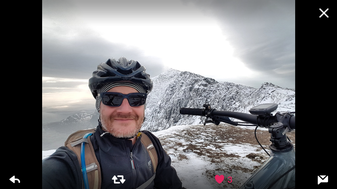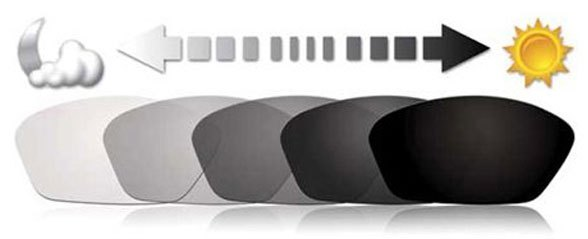There are many things to consider when buying mtb glasses; lens type, weather, budget. Here is a quick guide that will help you refine what you need from a pair of glasses and further guides to check out.
There are many factors to consider when you choose your next pair of mountain biking glasses
- Protection
- Lens type
- Weather
- Budget
- Style
- Prescription
- Summary
- More info
|
PROTECTION
The main benefit of mtb glasses will be protection. Protection from cold, winds, rain, trail and road debris, branches and the many other hazards from riding a wooded off road trail. Full frame options tend to feel more secure and are very robust, semi frameless designs can provide a unobscured view of the trail but may feel too close fitting for some people. Generally all sports glasses frames and lenses are made of plastic and are extremely robust. In addition, lenses made of polycarbonate (PC) material commonly offer excellent strength and impact resistance and also have the advantage of eliminating 100% of UV @ 380nm. |
|

LENS TYPE
The options are clear, fixed tint, polarized or photochromic, so depending on your activity, some styles may be more suitable than others.
Categories for the European standard
The options are clear, fixed tint, polarized or photochromic, so depending on your activity, some styles may be more suitable than others.
- Clear lenses. As the name would suggest clear lenses offer the simple solution and provide good clarity and basic protection. They can be good for night riding and in winter months.
- Polarised lenses, reduce reflected glare and can improve image perception, but these tend to mask small contours on the slope. Visible and UV transmittance may also be further reduced by the use of mirror coatings.
- Fixed tint lenses, these are available in the vast majority of glasses, they can be multi-coloured, red, blue and every colour option in between. Generally fixed tint lenses are category 3 (see below) so provide excellent protection from bright sunshine and are suitable for normal day riding. Certain lens colours are believed to improve image perception. Blue lenses will boost the greens and reds improving some aspects of the trail perception. Red lenses tend to improve the perception of browns which can improve terrain and contour perception. For overcast flat light days, with an over-abundance of blue light, yellow or rose tints may be used. Grey tints reduce transmittance across the spectrum and are the most neutral colour for light reduction
- Photochromic lenses These lenses contain a photosensitive dye embedded in the lens which changes colour in the presence of UV light. These lenses come in two colours grey and amber and have a range of absorption levels depending on their intended use. Optically, photochromic lenses are slightly thicker than standard lenses and offer optical clarity and light absorption for category 0-2 or 1-3 depending on the lens design selected - ' generally optically superior and preferred by those who demand the best'.
- Interchangeable lenses Some glasses designs are available with removable lenses allowing users to fit different lenses according to the weather conditions. This option is generally fixed tint, polarised or clear and can be a great solution if you know what the riding conditions are going to be for your day out.
- Vented lens The debate, does it really make a difference. Logic would have it that vented lenses help to keep the lenses fog free. The reality is that under normal riding conditions when you are moving the airflow around most glasses will keep them fog free. When airflow is most important is when you are stationary or moving slowly, in which case vented lenses will not improve airflow when there is no air flowing. For me (personal opinion) this is unnecessary and more of a good idea than any practical value.
Categories for the European standard
- Category 0 - 80%-100% transmission - for fashion, indoor use, or cloudy days
- Category 1 - 43%-80% transmission - low sun exposure
- Category 2 - 18%-43% transmission - medium sun exposure
- Category 3 - 8%-18% transmission - strong brightness, light reflected of water or snow
- Category 4 - 3%-8% transmission - intense sunshine for high mountains, glaciers; not for use when driving or on the road

WEATHER
UK weather is generally very variable, so light levels can vary extensively throughout the year and in different terrain. Your eyes by their nature will adapt to different light levels so providing you are not skiing or in the polar regions lenses with cat 0 - 3 are most suitable for UK conditions.
Optical coatings which improve water clearance from the lenses can be useful in rain. In addition, on very damp days with high humidity, fogging of lenses is more likely to be an issue so anti-fog coatings will have distinct benefits.
UK weather is generally very variable, so light levels can vary extensively throughout the year and in different terrain. Your eyes by their nature will adapt to different light levels so providing you are not skiing or in the polar regions lenses with cat 0 - 3 are most suitable for UK conditions.
Optical coatings which improve water clearance from the lenses can be useful in rain. In addition, on very damp days with high humidity, fogging of lenses is more likely to be an issue so anti-fog coatings will have distinct benefits.
BUDGET
Prices for glasses vary from £2.39 for screwfix safety glasses to £400 for Oakley Radar Pace.
Choose your budget and buy the best products you can get for the money.
The difference between the low end and high end glasses are a combination of tangible items such as comfort, weight, anti-fog and anti-scratch coatings, mirror coatings, optical clarity and intangible items such as brand value, style and lens colour
Prices for glasses vary from £2.39 for screwfix safety glasses to £400 for Oakley Radar Pace.
Choose your budget and buy the best products you can get for the money.
The difference between the low end and high end glasses are a combination of tangible items such as comfort, weight, anti-fog and anti-scratch coatings, mirror coatings, optical clarity and intangible items such as brand value, style and lens colour
|
Summary
1. Choose your budget 2. Decide on when you are most likely to use them, summer, day, night, all the time 3. Expect to replace the glasses every 12 -18 months as with regular use the lenses will get damaged 4. Wear them all the time when on you are on your bike 5. Join the ambassador program from Rad8 and you might get to test some for free |
|
More Info
Association of British Dispensing Opticians - Website www.abdo.org.uk
Wikipedia; https://en.wikipedia.org/wiki/Sunglasses
Chainreaction sunglasses buyers guide http://hub.chainreactioncycles.com/buying-guides/accessories/sunglasses-buying-
More Info
Association of British Dispensing Opticians - Website www.abdo.org.uk
Wikipedia; https://en.wikipedia.org/wiki/Sunglasses
Chainreaction sunglasses buyers guide http://hub.chainreactioncycles.com/buying-guides/accessories/sunglasses-buying-


 RSS Feed
RSS Feed
